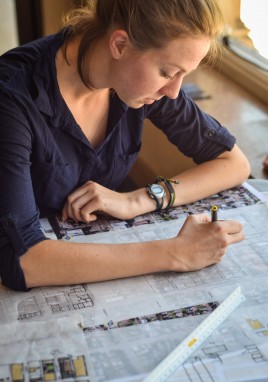Opticos Design’s newest team member Megan Reineccius writes about what it was like to participate in her first charrette.
When they told me we were going to work four 12-hour days in a row, I felt like I was being shipped off to architecture boot camp—and I was really excited. It’s exactly what I had come to Opticos for.
I graduated from the University of Notre Dame this spring with a Bachelor’s of Architecture degree, and then spent two weeks in Uganda working on a research project with Building Tomorrow, a non-profit organization that helps communities in East Africa build primary schools. I’d barely been at Opticos Design a week when they told me I’d be heading to Vallejo on my first charrette.

I participated in a few charrettes in school, but they were all significantly shorter. During one two-day event in Florida, we spent time meeting and listening to members of the community, followed by a 24-hour marathon design session, and then a short closing program to present what we’d come up with. The Opticos charrette would consist of several different sessions, as well as an open studio where we would get to meet and discuss our ideas with members of the community.
The space where we worked in Vallejo was a former restaurant with high ceilings, large windows, and a lot of natural light. The restaurant had closed only a few weeks before and is scheduled to reopen in the near future. In the meantime, it would be our home for the week.
We had to move our entire office to Vallejo—we took with us computers, art supplies, and huge maps and plans of the city. My first task was to create various SketchUp models to present the plans in 3D. Later, I had to realize the rest of the team’s designs through several hand-drawn illustrative plans. I also served as the team photographer.
During each session, we had anywhere between 30 to 50 people participating, and more people would just wander in off the street. A local artist had donated a huge inflatable lotus flower, which he placed on the sidewalk right out in front. A lot of people stopped by because they knew there was some kind of event happening that concerned their community—but many more walked in just because of that flower.
From time to time, I found myself having to explain to a new participant the difference between the Opticos approach and the approach of some other firms. Opticos really takes a holistic approach to community design, focusing on not just the street design, but also at what the buildings should look like and how they should function in the greater community. Acting as a representative of the Opticos brand so early in my tenure at the firm could have been an intimidating task, but it was actually really educational and helped me to get a better understanding of the firm, how it works, and what it believes in.
People were really excited that the charrette was happening, and it was so valuable to us as the design team to discover the things they found both important and troublesome about their community. During one of the sessions, community members participated in a dot exercise—people would point out issues in their town by placing color-coded dots on a map. Later, they could see that their voices had been heard when we showed them the resulting designs. It was amazing to see the positive response we got from everyone who participated in the charrette.
The days were long, but they were so packed with activity that we hardly noticed. I also spent a lot of time shadowing the other team members, which included Principal Stefan Pellegrini, Director of Form-Based Coding Tony Perez, Associate John Miki, and designers Cailin Shannon and Melia West. John, Cailin, and Melia taught me how to color—the markers we use on charrette at Opticos are a lot different from the watercolors we used in school. Believe it or not, coloring is a special skill that needs to be honed!
All in all, it was a really good introduction to my new position and a great chance to interact with the community and understand the reality of a plan. In school, all of our projects were theoretical; the Vallejo charrette was the first time I got to work in the real world. I didn’t know what to expect walking into the charrette, but the speed at which a plan could come together, especially one of such a magnitude as the Vallejo project, was truly impressive!
Megan is looking forward to her second charrette, which will also take place in Vallejo, CA, July 22 – 26.
Like this article? How about these: